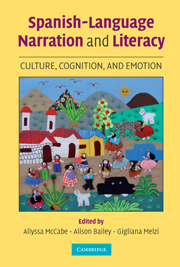Book contents
- Frontmatter
- Contents
- List of Contributors
- Preface
- Acknowledgments
- 1 Introduction
- PART ONE PARENT–CHILD NARRATIVES
- 2 Cultural Variations in Mother–Child Narrative Discourse Style
- 3 Early Sociocommunicative Narrative Patterns During Costa Rican Mother–Infant Interaction
- 4 Lessons in Mother–Child and Father–Child Personal Narratives in Latino Families
- 5 Evaluation in Spanish-Speaking Mother–Child Narratives: The Social and Sense-Making Function of Internal-State References
- 6 Love, Diminutives, and Gender Socialization in Andean Mother–Child Narrative Conversations
- PART TWO DEVELOPING INDEPENDENT NARRATION
- PART THREE NARRATIVE LINKS TO LITERACY AND OTHER SCHOOL ACHIEVEMENTS
- Author Index
- Subject Index
- References
4 - Lessons in Mother–Child and Father–Child Personal Narratives in Latino Families
Published online by Cambridge University Press: 05 June 2012
- Frontmatter
- Contents
- List of Contributors
- Preface
- Acknowledgments
- 1 Introduction
- PART ONE PARENT–CHILD NARRATIVES
- 2 Cultural Variations in Mother–Child Narrative Discourse Style
- 3 Early Sociocommunicative Narrative Patterns During Costa Rican Mother–Infant Interaction
- 4 Lessons in Mother–Child and Father–Child Personal Narratives in Latino Families
- 5 Evaluation in Spanish-Speaking Mother–Child Narratives: The Social and Sense-Making Function of Internal-State References
- 6 Love, Diminutives, and Gender Socialization in Andean Mother–Child Narrative Conversations
- PART TWO DEVELOPING INDEPENDENT NARRATION
- PART THREE NARRATIVE LINKS TO LITERACY AND OTHER SCHOOL ACHIEVEMENTS
- Author Index
- Subject Index
- References
Summary
Key Words: Parent–child narratives, father–child communication, mother–child communication, preschool children's social-cultural development, preschool children's narrative development, school readiness.
ABSTRACT
Children's early social exchanges, including the oral sharing of personal experiences, play an important role in their development. By talking about personal experiences (i.e., narratives), children come to understand their world and to develop a sense of self within a broader social-cultural context. This chapter describes mother–child and father–child narratives in a sample of 37 low-income Puerto Rican, Mexican, and Dominican immigrant families residing in New York City. We provide a qualitative examination of the major cultural lessons that were communicated by mothers and fathers in their shared stories with their preschoolers.
Between the spring of pre-kindergarten and fall of kindergarten, 16 girls and 21 boys were observed in their home. They were videotaped sharing 2-minute narratives with their mother and father (separately) about a “special memory.” Narratives were transcribed verbatim and the thematic content was explored and coded along three major cultural lessons.
First, parents emphasized the central role of family in their children's life, highlighting the importance of children identifying and loving their family members, maintaining ties with the family, and displaying appropriate behaviors toward relatives. Second, shared narratives communicated messages about gender roles, specifically in terms of emotions and activities that are associated with being male and female. Third, parents stressed the value of academic achievement, including the importance of working hard in school and feeling proud about scholastic accomplishments.
- Type
- Chapter
- Information
- Spanish-Language Narration and LiteracyCulture, Cognition, and Emotion, pp. 54 - 91Publisher: Cambridge University PressPrint publication year: 2008
References
- 17
- Cited by



